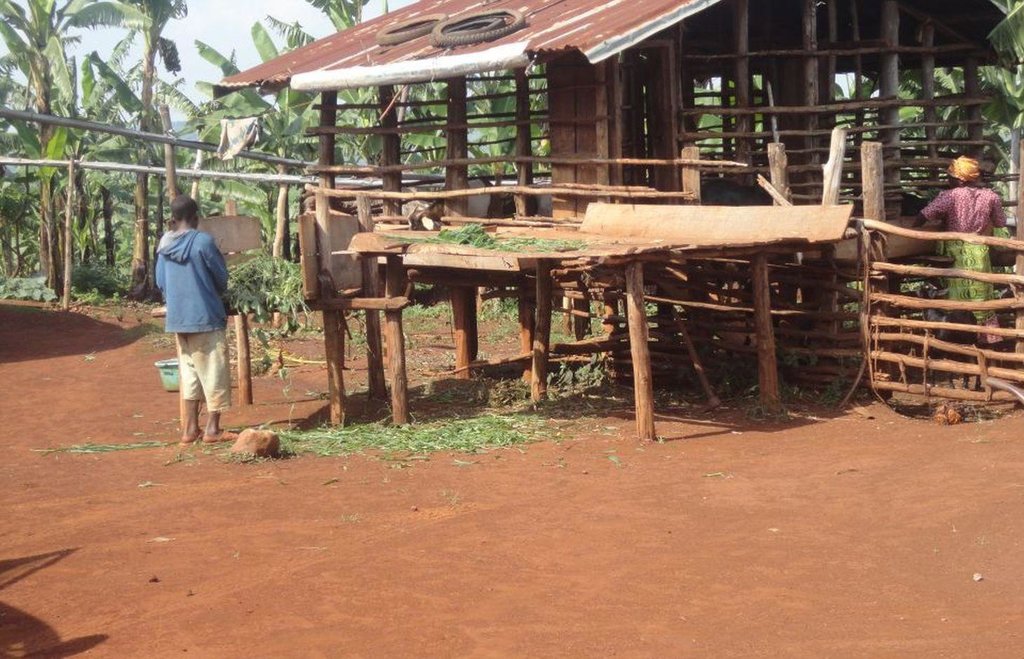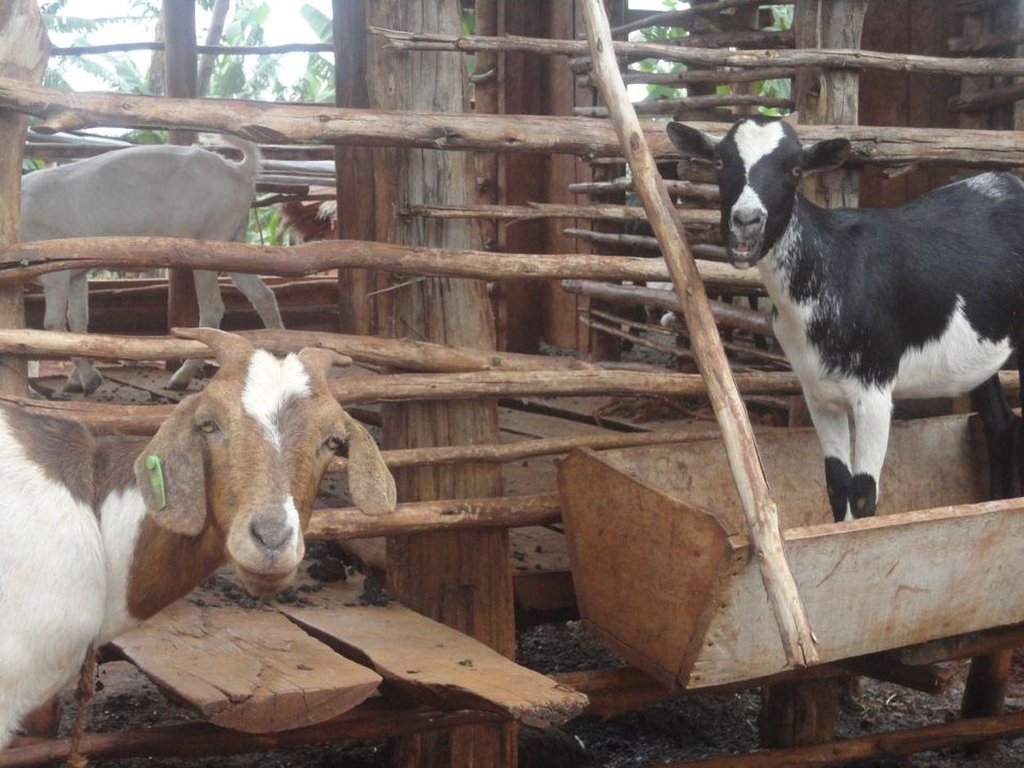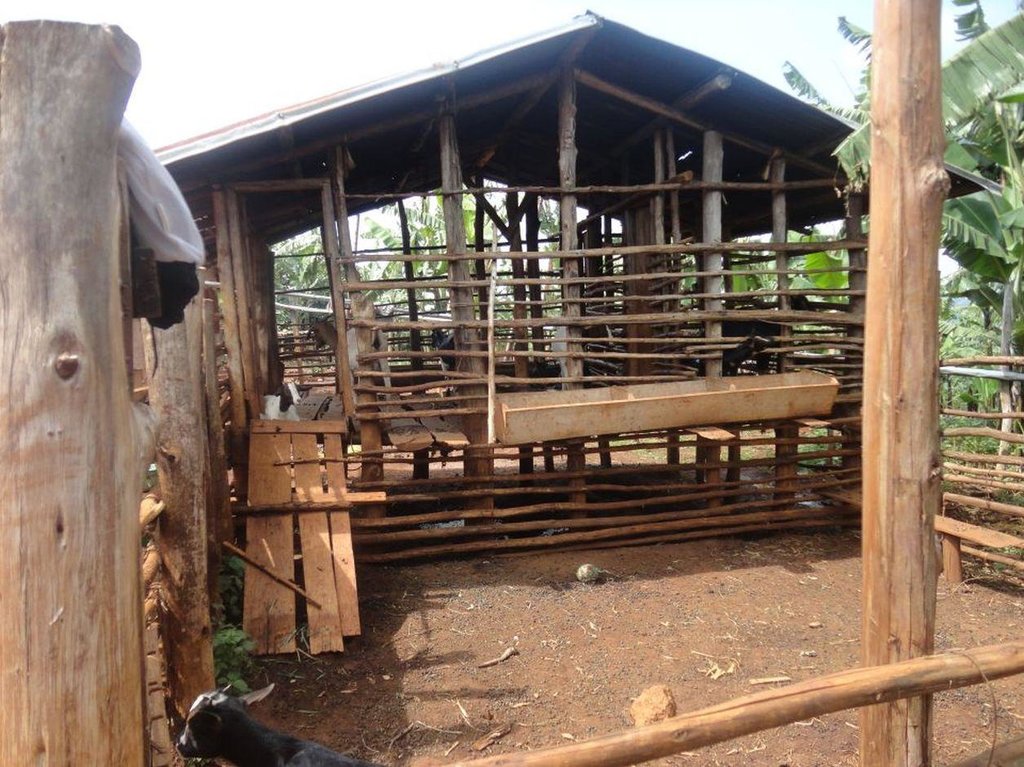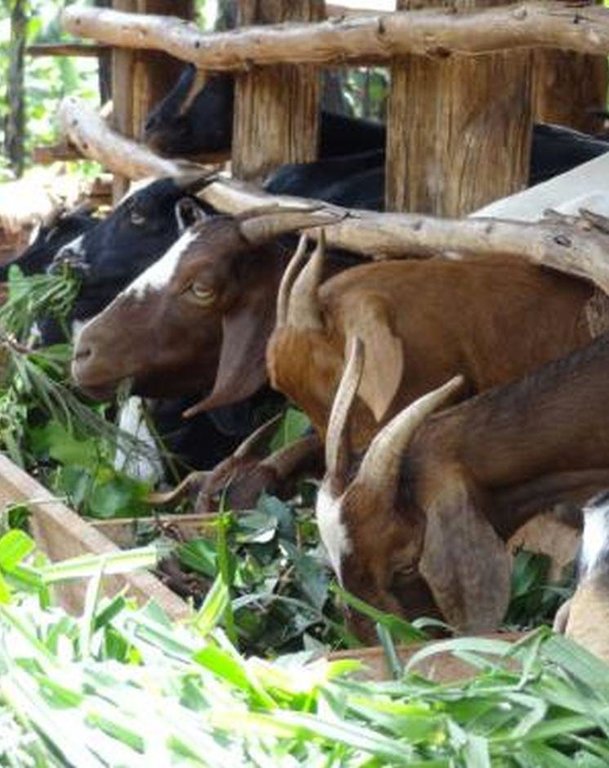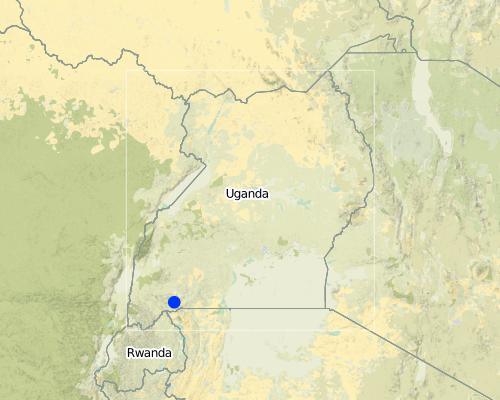Zero grazing [Уганда]
- Создание:
- Обновить:
- Составитель: Wilson Bamwerinde
- Редактор: –
- Рецензент: Fabian Ottiger
Okurisiza hamwe
technologies_1188 - Уганда
Просмотреть разделы
Развернуть все Свернуть все1. Общая информация
1.2 Контактные данные специалистов и организаций, участвующих в описании и оценке Технологии
Специалист по УЗП:
Специалист по УЗП:
Специалист по УЗП:
Название проекта, содействовавшего документированию/оценке Технологии (если применимо)
The Transboundary Agro-ecosystem Management Project for the Kagera River Basin (GEF-FAO / Kagera TAMP )Название организации (-ий), содействовавших документированию/оценке Технологии (если применимо)
Food and Agriculture Organization of the United Nations (FAO) - ИталияНазвание организации (-ий), содействовавших документированию/оценке Технологии (если применимо)
Ministry of Agriculture, Animal Industry, and Fisheries of Uganda (MAAIF) - Уганда1.3 Условия, регламентирующие использование данных, собранных ВОКАТ
Составитель и ответственный(-ые) специалист(-ы) согласны с условиями, регламентирующими использование собранных ВОКАТ данных:
Да
2. Описание Технологии УЗП
2.1 Краткое описание Технологии
Определение Технологии:
Stall-fed livestock production is an efficient method to produce organic fertilizers (manure) for the conservation and improvement of soil fertility.
2.2 Подробное описание Технологии
Описание:
Zero-grazing has been a common livestock (cattle and pigs) management practice in most areas of south-western Uganda due to reduced communal grazing land. In the predominantly annual cropping system communities, free grazing livestock often damage crops and are a major cause of conflict. On the other hand, farmers observe that crop yields have declined season after season. For example, the bunch of bananas has grown smaller, it has smaller fingers, and many banana stands have no fruit during much of the year. The most important ways through which croplands in Rubagano are degraded include nutrient transfer through harvest and crop residue movement and use; nutrient mining whereby continuous cultivation is done with little or no replenishment; and soil and water runoff on steep slopes. Farmers know that one of the most important ways to reverse declining soil fertility is to apply manure, but it is expensive. Therefore farmers acquired goats or pigs primarily for the provision of manure for their cropland, but also as a household income generating enterprise. In stall-fed goat or pig production, The zero-grazing unit is designed in such a way that it is well ventilated and protected from wind, rain and constant direct sunshine to avoid livestock developing coughs, colds and stress. The unit has 3 major parts: the feeding and rest area, the exercise area and the manure collection area. The feeding/rest area is raised 1 m above the ground. Below it is the manure collection area and above it, a corrugated iron roof. There is a feeding vat on each side of the feeding/rest area in which mixed fodder is fed to the livestock. A wooden food preparation slab for cutting and mixing fodder is in front of the feeding/rest area. The unit for housing 12 goats is 4 m by 8 m on the ground and 3 m high at the feeding area.
Purpose of the Technology: The major objective of stall-feeding is to maximize manure collection for sustaining soil fertility in cropland. Other goals are to improve household income, reduce expenditure on pests and disease management through livestock isolation from other animals and to reduce labor by cutting and storing fodder for use over a period instead of grazing in distant pastures daily.
Establishment / maintenance activities and inputs: The materials required for establishment of the zero-grazing unit for goats are wooden posts or poles, cut-off planks, wooden slats/timber, iron sheets and nails. The 4 m by 4 m feeding/rest area is raised 1 m above the ground on strong Eucalyptus or pine posts of diameter 5-10 cm. Its wall is 2 m high and is made of widely spaced cut-off planks or light wooden poles not more than 3 cm diameter nailed to strong upright posts. The floor is made of wooden slats placed 2 cm apart, big enough to allow livestock droppings to fall through but too small for adult goats’ or kids’ hooves pass, in order to avoid injury to livestock. There is a 1.5 m by 0.5 m feeding vat on each side of the feeding/rest area and a 1 m by 1 m fodder mixing wooden slab at the front. On the ground to one side of the feeding/rest area is the 4m by 4m exercise area. The unit can be constructed at any time of the year.
Natural / human environment: Regular maintenance of the unit is done to ensure the floor does not develop holes that can lead to injury of the livestock, and the roof does not leak when it rains. Increased manure collection and application increases crop yields and supports crop diversification.
2.3 Фотографии, иллюстрирующие Технологию
2.5 Страна/ регион/ места, где применяется Технология, информация о которых собрана в данной Анкете
Страна:
Уганда
Административная единица (Район/Область):
Uganda
Более точная привязка места:
Mbarara District
Пояснения:
Boundary points of the Technology area: -0.86313 30.62564; -0.86314 30.62561; -0.86316 30.62569; -0.86319 30.62567
Map
×2.6 Сколько лет применяется данная Технология
Если год начала применения Технологии достоверно неизвестен, дайте примерную оценку:
- менее 10 лет назад (недавняя)
2.7 Внедрение Технологии
Укажите, как именно Технология УЗП была внедрена:
- через проекты/ внешнее вмешательство
Пояснения (тип проекта и т.д.):
This technology was introduced in 2008 by NAADS and later by Africa2000 with aim to improve manure and compost production in Kagera region. Recently, Kagera TAMP project provided additional support to introduce exotic breeds of the goats and increase livestock productivity.
3. Классификация Технологии УЗП
3.1 Основные цели и задачи реализации Технологии
- снижение или предотвращение деградации земель, восстановление нарушенных земель
- сохранение экосистем
3.2 Текущий(-ие) тип(-ы) землепользования на территории, где применяется Технология

Пахотные угодья и плантации
- Однолетние культуры
Основные сельскохозяйственные культуры (товарные и продовольственные):
Major cash crop: Irish potatoes, bananas, beans
Major food crop: Irish potatoes, bananas, beans

Пастбищные угодья
Интенсивный выпас/ выращивание кормов:
- Стойловое содержание/ нулевой выпас
Пояснения:
Major land use problems (compiler’s opinion): Reduction of soil organic matter content
Major land use problems (land users’ perception): Decline of soil fertility and decreased crop yields
Cut-and-carry/ zero grazing: Yes
Future (final) land use (after implementation of SLM Technology): Grazing land: Gi: Intensive grazing/ fodder production
Type of cropping system and major crops comments: other crops like peas, millet, maize and sorghum are also grown.
Livestock is grazing on crop residues
Если использование земель изменилось с началом применения Технологии, укажите тип землепользования до применения Технологии:
Grazing land: Ge: Extensive grazing land
3.3 Дополнительная информация о землепользовании
Обеспеченность водой участков, где реализуется Технология :
- богарные земли
Число урожаев за год:
- 2
Поясните:
Longest growing period in days: 120 Longest growing period from month to month: February to May Second longest growing period in days: 90 Second longest growing period from month to month: September to November
3.4 Категория УЗП, к которой относится Технология
- Кочевое животноводство и пастбищное хозяйство
- Комлексное земледельческо-животноводческое хозяйство
3.5 Распределение Технологии по площади
Пояснения:
Total area covered by the SLM Technology is 0.002 km2.
There are 20 zero grazing units (goats and pigs) in the area and with a total area of about 2 hectares. The technology is being adopted slowly throughout the community.
3.6 Мероприятия УЗП, выполняемые в рамках Технологии

Агрономические мероприятия
- A2: Органическое вещество/ почвенное плодородие

Мероприятия с использованием растительности
- Р2: Злаковые и многолетние травянистые растения

управленческие мероприятия
- У2: Изменение формы/ интенсивности хозяйствования
Пояснения:
Main measures: agronomic measures, vegetative measures, management measures
Type of agronomic measures: manure / compost / residues
Type of vegetative measures: aligned: -linear
3.7 Основные проблемы деградации земель, на решение которых направлена Технология

ухудшение химических свойств почв
- Хп: Снижение плодородия и уменьшение содержания органического вещества (вызванное не эрозией, а другими причинами)

биологическая деградация
- Бр: сокращение растительного покрова
Пояснения:
Main type of degradation addressed: Cn: fertility decline and reduced organic matter content, Bc: reduction of vegetation cover
Main causes of degradation: soil management (Poor methods of cultivation), crop management (annual, perennial, tree/shrub) (Poor agronomic practices), over-exploitation of vegetation for domestic use (Vegetation destroyed for domestic use (firewood and thatch).)
Secondary causes of degradation: education, access to knowledge and support services
3.8 Предотвращение и снижение деградации земель, или восстановление нарушенных земель
Укажите цель Технологии по отношению к деградации земель :
- предотвращение деградации земель
- снижение деградации земель
Пояснения:
Main goals: mitigation / reduction of land degradation
Secondary goals: prevention of land degradation
4. Технические характеристики, мероприятия по практической реализации, вложения и стоимость
4.1 Технический рисунок, иллюстрирующий Технологию
Автор:
Byonabye Proscovia, Kagera TAMP, Kabala
4.2 Спецификация / пояснения к техническому рисунку
Details of zero grazing shed structure : A. Overview of the livestock shed with manure colelction area (below) B. View on the feeding arrangement with the fodder vats abouve ground level C. Deatils of the fodder vat D. Overview of the fodder preparation structures
Location: Rubagano, Mwizi, Mbarara District. Uganda
Date: 29-DEC-2013
Technical knowledge required for field staff / advisors: moderate (Comprehensive knowledge on shed construction (e.g. planning, design of shed levels) and livestock management (fodder quality, feeding, diseases))
Technical knowledge required for land users: moderate (Comprehensive knowledge on shed construction (e.g. planning, design of shed levels) and livestock management (fodder quality, feeding, diseases))
Main technical functions: improvement of ground cover, increase in organic matter, increase in nutrient availability (supply, recycling,…)
Secondary technical functions: improvement of surface structure (crusting, sealing), promotion of vegetation species and varieties (quality, eg palatable fodder)
Manure / compost / residues
Material/ species: Manure (Pigs or goats)
Aligned: -linear
Vegetative material: G : grass
Number of plants per (ha): 900
Vertical interval between rows / strips / blocks (m): 3
Spacing between rows / strips / blocks (m): 3
Grass species: Pennisetum purpereum (napier grass), Calliandra Spp.)
Slope (which determines the spacing indicated above): 25-30%
Change of land use type: Mixed crop and livestock husbandry
Change of land use practices / intensity level: Planting fodder in addition to traditional annual and perennial crops
4.3 Общая информация по необходимым вложениям и стоимости
другая/ национальная валюта (название):
UGX
Укажите обменный курс между долларом США и местной валютой (если уместно): 1 доллар США =:
2600,0
Укажите среднюю дневную заработную плату наемных работников:
3.85
4.4 Мероприятия, необходимые для начала реализации
| Деятельность | Тип мероприятия | Сроки | |
|---|---|---|---|
| 1. | Purchase of tools | Агрономические | Wet season |
| 2. | Purchase of construction materials | Агрономические | |
| 3. | Construction of zero grazing shed ( including vats and manura collecion area) | Агрономические | |
| 4. | Purchase of livestock | Агрономические | |
| 5. | Grass seed procurement and sowing | Мероприятия с использованием растительности | Wet season |
| 6. | Converting part of the cropland (annual and perrenial crops) into fodder production | Управленческие |
4.5 Вложения и затраты, необходимые для начала реализации
| Опишите затраты | Единица | Количество | Затраты на единицу | Общая стоимость на единицу | % затрат, оплаченных землепользователями | |
|---|---|---|---|---|---|---|
| Оплата труда | Construction of zero grazing shed ( including vats and manura collecion area) | ha | 1,0 | 115,4 | 115,4 | 100,0 |
| Оборудование | Tools | Set | 1,0 | 115,4 | 115,4 | 100,0 |
| Строительные материалы | Tree poles,nails,sorghum stalk | ha | 1,0 | 38,46 | 38,46 | 100,0 |
| Строительные материалы | Corrugated iron sheets | ha | 1,0 | 250,0 | 250,0 | 100,0 |
| Другие | Livestock (3 Does) | ha | 1,0 | 173,1 | 173,1 | 100,0 |
| Общая стоимость запуска Технологии | 692,36 | |||||
Пояснения:
Duration of establishment phase: 6 month(s)
Lifespan of:
Tools - 1 year
Construction material - 10 years
Zero grazing shed - 1 year
Livestock - 20 years
4.6 Поддержание/ текущее обслуживание
| Деятельность | Тип мероприятия | Сроки/ повторяемость проведения | |
|---|---|---|---|
| 1. | Cutting and carrying and application of fodder | Агрономические | Daily |
| 2. | Collection, composting and application of manure | Агрономические | Daily |
| 3. | Purchase of tools and materials for reconstruction/repairs of the shed structure | Агрономические | annual |
| 4. | Weeding and gapping | Мероприятия с использованием растительности | Seasonal |
4.7 Стоимость поддержания/ текущего обслуживания ( в год)
| Опишите затраты | Единица | Количество | Затраты на единицу | Общая стоимость на единицу | % затрат, оплаченных землепользователями | |
|---|---|---|---|---|---|---|
| Оплата труда | Labour | ha | 1,0 | 38,46 | 38,46 | |
| Оборудование | Tools | ha | 1,0 | 11,54 | 11,54 | 100,0 |
| Строительные материалы | Tree poles,nails,sorghum stalk | ha | 1,0 | 3,85 | 3,85 | 100,0 |
| Строительные материалы | Corrugated iron sheets | ha | 1,0 | |||
| Другие | Livestock (3 Does) | ha | 1,0 | 18,0 | 18,0 | 100,0 |
| Общая стоимость поддержания Технологии | 71,85 | |||||
Пояснения:
Machinery/ tools: Panga, hoe, tree poles nails, soka jembe, spade, and wheel barrow., Hand hoe, panga.
The costs were calculated for the construction of the shed, acquisition of 3 does and establishment of fodder crops on part of cropland formerly used for annual and perrenial crops. The calculations were done for the technology in August 2011.
4.8 Наиболее значимые факторы, влияющие на стоимость затрат
Опишите наиболее значимые факторы, влияющие на стоимость затрат:
The most determinate factors in the establishment of the technology are: labour for planting, maintaining and cutting grass and other pastures and carrying the fodder to the zero-grazing unit; labour for fetching water for the animals; and labour for removing and composting manure and spreading into the garden.
5. Природные и социально-экономические условия
5.1 Климат
Среднегодовое количество осадков
- < 250 мм
- 251-500 мм
- 501-750 мм
- 751-1000 мм
- 1001-1500 мм
- 1501-2000 мм
- 2001-3000 мм
- 3001-4000 мм
- > 4000 мм
Укажите среднегодовое количество осадков (если известно), мм:
1041,00
Агроклиматическая зона
- Умеренно-влажная
Thermal climate class: tropics. All months above 18°C.
Rubagano receives at least 6 months of rain in 2 seasons, February to May and September to November
5.2 Рельеф
Склоны (преобладающие):
- пологие (0-2%)
- покатые (3-5%)
- покато-крутые (6-10%)
- крутые (11-15%)
- очень крутые (16-30%)
- чрезвычайно крутые (31-60%)
- обрывистые (>60%)
Формы рельефа:
- плато/ равнины
- гребни хребтов/холмов
- склоны гор
- склоны холмов
- подножья
- днища долин
Зона высотной поясности:
- 0-100 м над уровнем моря
- 101-500 м н.у.м.
- 501-1000 м н.у.м.
- 1001-1500 м н.у.м.
- 1501-2000 м н.у.м.
- 2001-2500 м н.у.м.
- 2501-3000 м н.у.м.
- 3001-4000 м н.у.м.
- > 4 тыс. м н.у.м.
Укажите, приурочено ли применение Технологии к специфическим условиям:
- в ситуациях вогнутого рельефа
Комментарии и дополнительные сведения по условиям рельефа/ топографии :
Altitudinal zone: 1501-2000 m a.s.l. (1740 m.a.s.l)
Slopes on average: Hilly (Fairly steep slopes in places)
5.3 Почвы
Средняя мощность почв:
- поверхностные (0-20 см)
- неглубокие (21-50 см)
- умеренно глубокие (51-80 см)
- глубокие (81-120 см)
- очень глубокие (> 120 см)
Гранулометрический состав (верхнего горизонта):
- грубый крупнозернистый/ лёгкий (песчаный)
Содержание органического вещества в верхнем горизонте:
- среднее (1-3%)
Если возможно, приложите полное описание почв или укажите доступную информацию, например тип почв, рH/ кислотность почв, ёмкость катионного обмена, содержание азота, содержание солей и т.д.
Soil depth on average: Shallow (Mother rock easily reached on pitting)
Soil texture: Coarse/light (Sand and stones)
Soil fertility: Low (Fertility depleted; being slowly replenished by application of technology)
Soil drainage/infiltration: Good (Water easily penetrates into the soil)
Soil water storage capacity: Low (Crops easily dry during the dry spell)
5.4 Доступность и качество воды
Уровень грунтовых вод:
> 50 м
Доступность поверхностных вод:
недостаточны/ отсутствуют
Качество воды (без обработки):
питьевая вода плохого качества (необходима обработка)
Комментарии и дополнительная информация по качеству и количеству воды:
Ground water table: >50m (Not possible to reach water table)
Availability of surface water: Poor/none (No surface water except when it rains)
Water quality (untreated): Poor drinking water (treatement required, muddy water collected by damming runoff in natural rock depressions)
5.5 Биоразнообразие
Видовое разнообразие:
- низкое
Комментарии и дополнительная информация по биоразнообразию:
Low, noticed improvements after application of the technology
5.6 Характеристика землепользователей, применяющих Технологию
Рыночная ориентация производства:
- смешанное (самообеспечение/ товарное хозяйство
Доходы из других источников:
- 10-50% всех доходов
Относительный уровень достатка:
- средний
Индивидуальное или коллективное хозяйство:
- частное/ домовладение
Уровень механизации:
- ручной труд
Пол:
- женщины
- мужчины
Укажите другие важные характеристики землепользователей:
Land users applying the Technology are mainly common / average land users
Difference in the involvement of women and men: No difference in involvement of men and women.
Population density: 100-200 persons/km2
Annual population growth: 2% - 3%
14% of the land users are rich and own 37% of the land.
48% of the land users are average wealthy and own 42% of the land.
21% of the land users are poor and own 14% of the land.
17% of the land users are poor and own 7% of the land.
Off-farm income specification: There is increased yield where the technology has been applied, increasing the income generated on-site thereby reducing off-farm percentage.
Level of mechanization: Manual work (use hand hoes)
Market orientation: Mixed (Some crops are sold to generate household income. Goats will be mainly for sale)
5.7 Средний размер земельных участков, арендуемых или находящихся в собственности землепользователей, применяющих Технологию
- < 0,5 га
- 0,5-1 га
- 1-2 га
- 2-5 га
- 5-15 га
- 15-50 га
- 50-100 га
- 100-500 га
- 500-1000 га
- 1000-10000 га
- > 10000 га
Считается ли это мелким, средним или крупным хозяйством (по местным масштабам)?
- мелкое
Пояснения:
Some households have more while others have less land.
5.8 Собственность на землю, права на земле- и водопользование
Землевладелец:
- индивидуальная, не оформленная в собственность
Право землепользования:
- индивидуальное
Право водопользования:
- неограниченное (неконтролируемое)
- индивидуальное
Пояснения:
Individual land ownership. Recent introduction of the water harvesting measures provided land owners with access to own water sources
5.9 Доступ к базовым услугам и инфраструктуре
медицинское обслуживание:
- плохой
- средний
- хорошая
образование:
- плохой
- средний
- хорошая
технические консультации:
- плохой
- средний
- хорошая
занятость (вне хозяйства):
- плохой
- средний
- хорошая
рынки:
- плохой
- средний
- хорошая
электроснабжение:
- плохой
- средний
- хорошая
транспорт и дорожная сеть:
- плохой
- средний
- хорошая
водоснабжение и канализация:
- плохой
- средний
- хорошая
финансовые услуги:
- плохой
- средний
- хорошая
6. Воздействия и заключительные положения
6.1 Влияние Технологии УЗП в пределах территории ее применения
Социально-экономическое воздействие
Продуктивность
производство сельскозяйственных культур
Количество до применения УЗП :
10kg
Количество после применения УЗП:
60kg
Комментарий/ пояснения:
increased yields for beans realised.
производство кормов
качество кормов
производство продуктов животноводства
риск потери продуктивности
разнообразие продукции
площадь, используемая для производства продукции
Доходы и затраты
доходы хозяйства
Количество до применения УЗП :
23dollars per yr
Количество после применения УЗП:
92 dollars per yr.
Комментарий/ пояснения:
yields increased from sell of goats
разнообразие источников дохода
объем работ
Комментарий/ пояснения:
As there is now a lot more activity on-farm
Социальное и культурное воздействие
продовольственная безопасность/ самообеспечение
местное самоуправление
институты госуправления
знания в области УЗП/ деградации земель
Комментарий/ пояснения:
Vegetation cover has been improved.
Improved livelihoods and human well-being
Комментарий/ пояснения:
Food security and household income have improved. This has resulted in children in these households having more time for school and in case of illness, there in some money for accessing treatment.
Экологическое воздействие
Почвы
почвенный покров
круговорот/ восполнение питательных веществ
почвенное / подземное органическое вещество/ углерод
Биоразнообразие: растительность, животный мир
биомасса/ содержание углерода в надземной биомассе
разнообразие местообитаний
6.2 Влияние Технологии за пределами территории ее применения
ущерб прилегающим полям
Комментарий/ пояснения:
livestock is confined
6.3 Подверженность и чувствительность Технологии УЗП к постепенным изменениям климата и экстремальным погодным явлениям/ стихийным бедствиям, связанным с изменением климата (в понимании землепользователей)
Постепенное изменение климата
Постепенное изменение климата
| Сезон | Тип изменения климата/ экстремального явления | Насколько успешно Технология справляется с этим? | |
|---|---|---|---|
| среднегодовые температуры | увеличилось | хорошо |
Экстремальные явления, связанные с изменением климата (стихийные бедствия)
Погодные стихийные бедствия
| Насколько успешно Технология справляется с этим? | |
|---|---|
| местные ливневые дожди | хорошо |
Стихийные бедствия климатического характера
| Насколько успешно Технология справляется с этим? | |
|---|---|
| засухи | хорошо |
Пояснения:
Forage and fodder usually become scorched during seasons of long drought and livestock may die from lack of food. Grass is cut in the wet season while it is plentiful and turned into hay for the time of scarcity. For this, a barn unit needs to be constructed.
6.4 Анализ эффективности затрат
Насколько получаемый результат сопоставим с первоначальными вложениями (с точки зрения землепользователей)?
Эффективность затрат в краткосрочной перспективе:
отрицательно
Эффективность затрат в долгосрочной перспективе:
очень позитивное
Насколько получаемый результат сопоставим с текущими расходами по поддержанию технологии (с точки зрения землепользователей)?
Эффективность затрат в краткосрочной перспективе:
позитивное
Эффективность затрат в долгосрочной перспективе:
очень позитивное
Пояснения:
The benefits far outweigh the establishment and maintenance costs. The negative on short-term returns is due to the cost of the technology (construction and procuring livestock) which is a little high for the farmers in this area.
6.5 Внедрение Технологии
Если возможно, дайте количественную характеристику (число домохозяйств и/или площадь применения):
20 on 2 hectares
Среди применяющих Технологию землепользователей, какова доля лиц, применяющих её по собственной инициативе, т.е. без какого-либо материального стимулирования со стороны?
- 10-50%
Пояснения:
90% of land user families have adopted the Technology with external material support
18 land user families have adopted the Technology with external material support
Comments on acceptance with external material support: The does were supplied to farmers using project funds.
10% of land user families have adopted the Technology without any external material support
2 land user families have adopted the Technology without any external material support
Comments on spontaneous adoption: these farmers are rich and procured the technology without support from the project
There is a moderate trend towards spontaneous adoption of the Technology
Comments on adoption trend: 20 households in one village have adopted the technology
6.7 Сильные стороны/ преимущества/ возможности Технологии
| Сильные стороны/ преимущества/ возможности по мнению землепользователей |
|---|
|
Technology easy to establish and maintain How can they be sustained / enhanced? Proper management of the livestock |
|
Helps in soil fertility management How can they be sustained / enhanced? Good manure management |
|
Imporove soil cover and reduce soil erosion How can they be sustained / enhanced? using the manure in a proper /recommended way i.e. using it when planting or putting it in the plot before primary cultivation |
| Сильные стороны/ преимущества/ возможности по мнению составителя или других ключевых специалистов |
|---|
|
Animals are fed on selected pasture How can they be sustained / enhanced? Promote the growing of that pasture |
|
The technology promotes us of organic manure How can they be sustained / enhanced? Use of compost pits to recycle the wastes into manure |
6.8 Слабые стороны/ недостатки/ риски Технологии и пути их преодоления
| Слабые стороны/ недостатки/ риски по мнению составителя или ответственных специалистов | Возможные пути их преодоления/снижения? |
|---|---|
| The technology may contribute to loss of vegetation | Planting pasture & other grass for feeding the animals |
7. Справочные материалы и ссылки
7.2 Ссылки на опубликованные материалы
Название, автор, год публикации, ISBN:
Kagera TAMP project website
Где опубликовано? Стоимость?
http://www.fao.org/nr/kagera/en/
Ссылки и модули
Развернуть все Свернуть всеСсылки
Нет ссылок
Модули
Нет модулей



